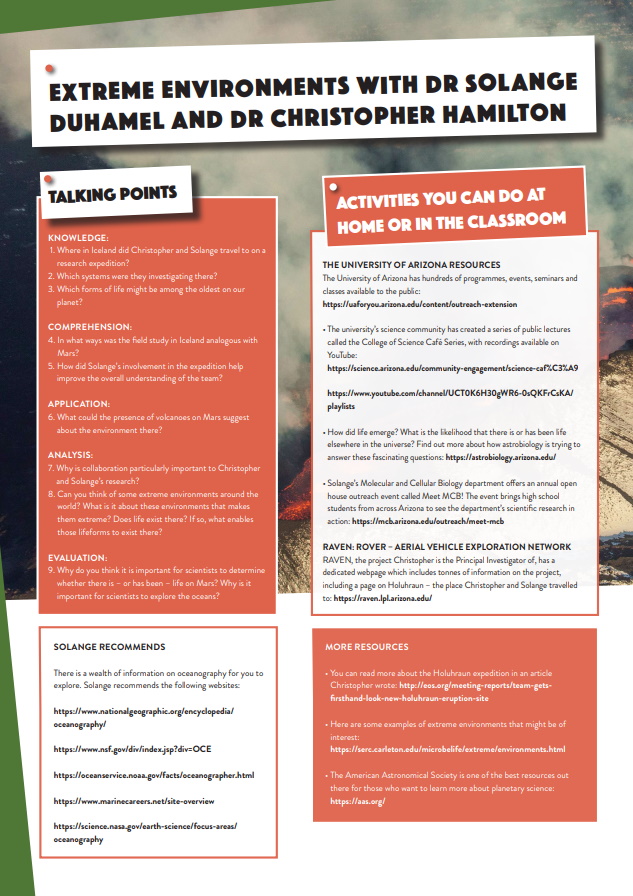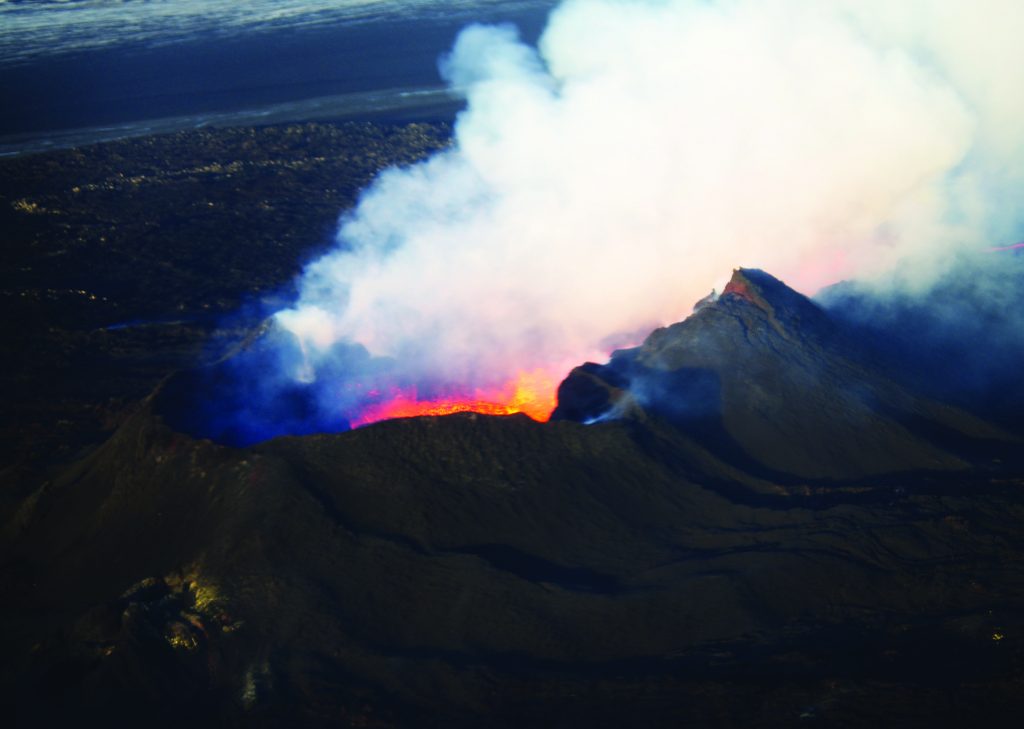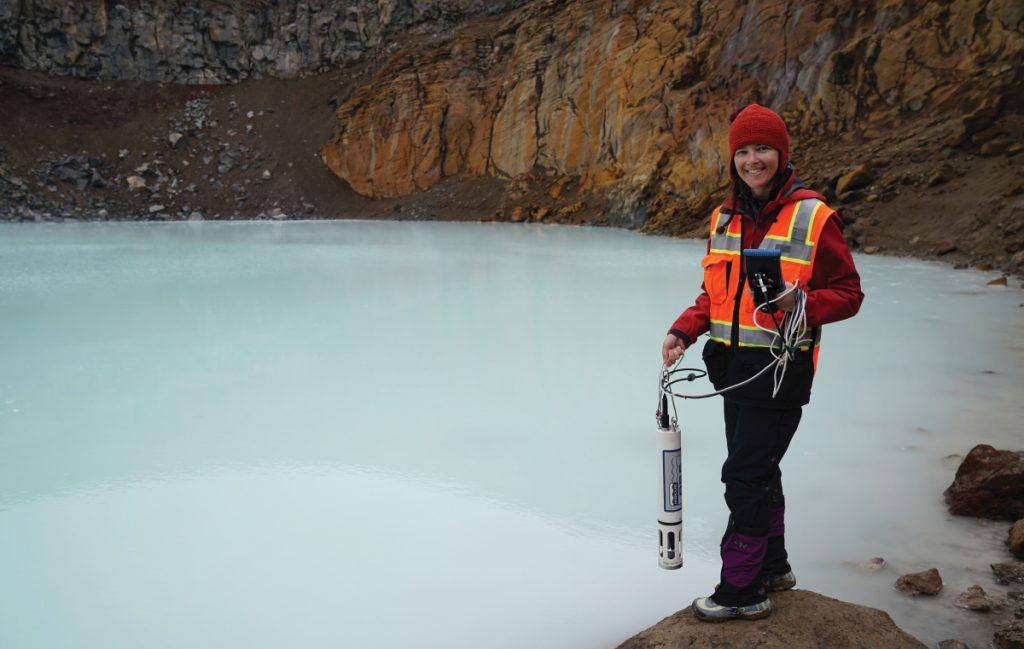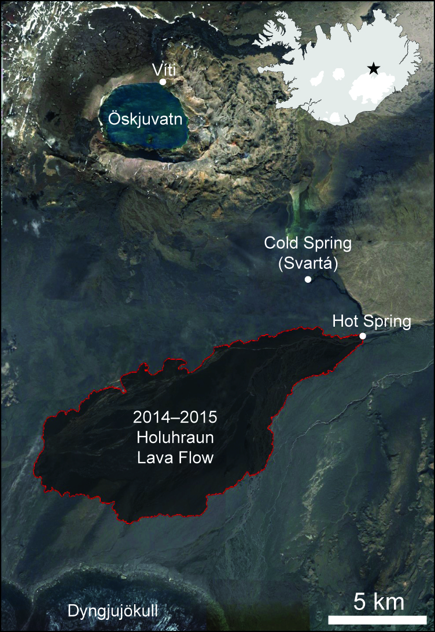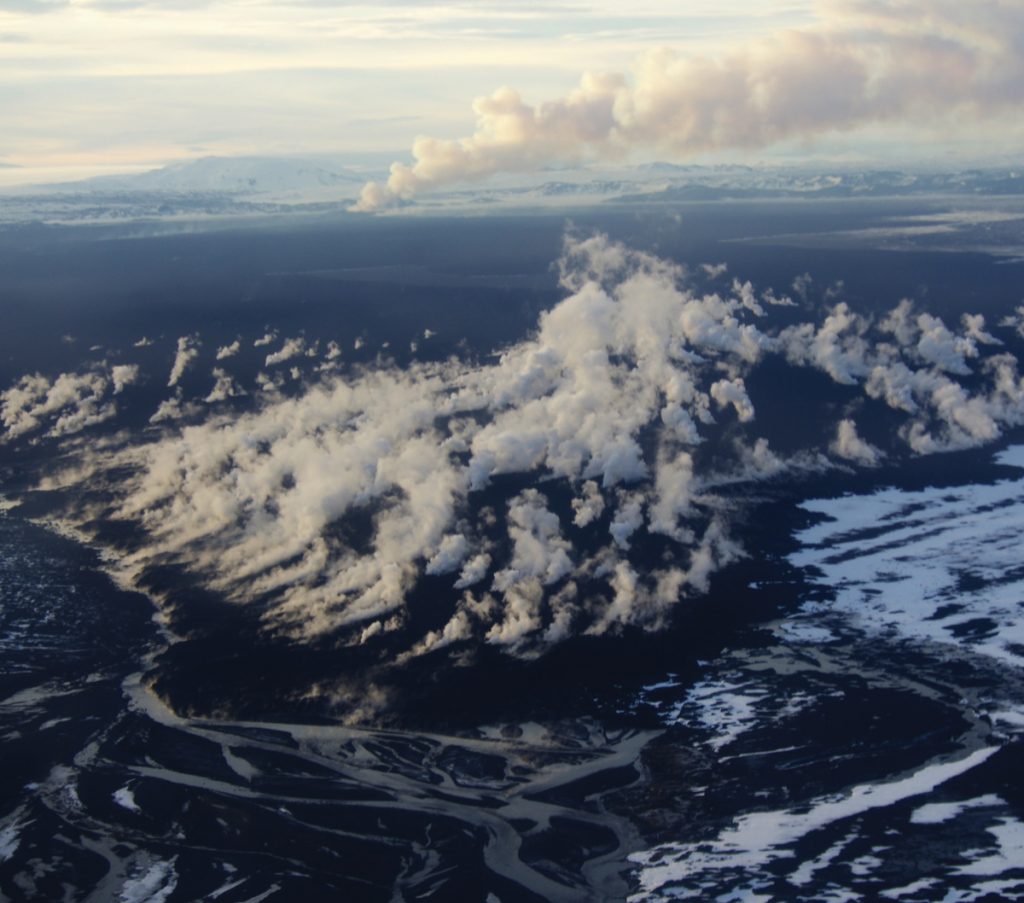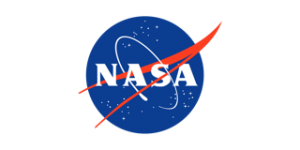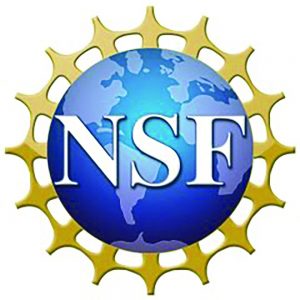How microbes in Iceland can teach us about possible life on Mars
Dr Solange Duhamel and Dr Christopher Hamilton, based at the University of Arizona, have brought together their respective expertise in environmental microbiology and planetary science to investigate how life could survive on Mars. Fascinatingly, this has been done by exploring an area in Iceland that resembles the red planet
When we think of astronauts, deep-sea exploration is not the first thing that springs to mind. Similarly, space walks are not usually associated with oceanographers. And yet, oceans are often used in the preparation for space exploration. For instance, lengthy dives in weighted diving suits mimic the Moon’s low-gravity environment, and underwater research labs provide a practice setting for life on the International Space Station.
Nonetheless, the connection between our oceans and space can go far beyond space walking and deep-sea diving. Dr Solange Duhamel, an oceanographer, and Dr Christopher Hamilton, a planetary scientist, both based at the University of Arizona, have pooled their expertise in two very different disciplines to work on collaborative research projects in astrobiology, including investigations of hydrothermal systems in Iceland, to uncover what life in these extreme environments might reveal about life on Mars.
WHY DID SOLANGE AND CHRISTOPHER GO ON AN EXPEDITION TOGETHER?
Six months after the end of the 2014–2015 Holuhraun eruption in Iceland, Christopher led a team that studied the lava flow-field and observed a lava-induced hydrothermal system where the lava had entered a segment of the Jokulsa a Fjollum river. However, the initial team did not include any biologists and so, Christopher invited Solange – an oceanographer and expert in environmental microbiology and biogeochemistry – to join them the following year. With Solange on board, the team returned to the field site to investigate the unusual forms of life that had developed within Holuhraun’s hydrothermal systems.
Christopher is a planetary volcanologist and the Holuhraun eruption – which took place in a pristine part of the Iceland highlands – was immediately important as an analogue for Mars. In contrast, Solange is an oceanographer, with expertise in how life can thrive in extreme environments. Solange explains, “When I joined the expedition led by Christopher, the team was composed of geologists and planetary scientists – I was the only biologist. I brought new competences to the group and together we have been able to gather a complementary set of physical, chemical and biological data to characterise the ecology and biogeochemistry of the system at Holuhraun.”
WHAT MAKES A TERRAIN, SUCH AS HOLUHRAUN, ANALOGOUS WITH MARS?
Holuhraun is located within a barren sand sheet in Icelandic highlands, between the Vatnajokull ice cap and the Askja central volcano. “This high-altitude location has very little vegetation and resembles the surface of Mars. Volcanic eruptions on Mars also tend to be larger than recent eruptions on Earth, but the 2014–2015 Holuhraun eruption generated the largest outpouring of lava in Iceland during the past 235 years,” explains Christopher. “This makes the terrain similar to Martian lava flows.”
WHAT HAVE THE LAVA-INDUCED HYDROTHERMAL SYSTEMS REVEALED ABOUT MARS?
Solange explains, “When the Holuhraun lava flow inundated a segment of the Jokulsa a Fjollum river, it created unusual forms of hydrothermal activity. This was very exciting because those conditions could mimic those found on Mars in the past.”
Given the extreme conditions on Mars, if there is life on the Red Planet, it must be adapted to extreme environments. On Earth, thermophiles (organisms that thrive at high temperatures between 50⁰C and 122⁰C), may be among the oldest forms of life on the planet. With so many volcanoes on Mars, it is possible that large lava flows – similar to the ones in Iceland – may have interacted with near-surface water to generate hydrothermal environments.
“One of the astonishing things about the recent Holuhraun eruption is how quickly life populated its lava-induced hydrothermal systems,” says Christopher. “Just months after the end of the eruption, hot springs emerging from the lava flow contained algae and other microorganisms that may have been hiding dormant in the sand, just waiting for the right conditions to spring back to life.” If similar microbes live on Mars, large volcanic eruptions might hold the key to the episodic flourishing of microbial life on Mars.
COULD THERE BE LIFE ON MARS?
Solange and Christopher’s studies have shown that life very quickly emerged in the lava-induced hydrothermal systems, which gives rise to the possibility that there could well be life in similar environments on Mars. The identification of potentially habitable locations on other planets is a fundamentally important issue, and NASA’s Mars 2020 mission – currently en route to Mars – will be the first rover capable of collecting astrobiologically relevant samples for return to laboratories on the Earth. This mission is particularly exciting because it will land in Jezero Crater, which includes volcanic units that may have generated hydrothermal systems just like the ones observed in Iceland.
A MARRIAGE OF DISCIPLINES
Solange and Christopher met while working on separate research projects in Hawaii twelve years ago. Now married, they have not only established their own successful careers investigating different scientific problems in environmental microbiology (Solange) and planetary science (Christopher), but have also come together to work on fascinating projects, such as this one in Iceland.
From those individual research projects in Hawaii, to travelling the world and conducting their own novel research, to collaborating together to investigate life in extreme environments, Solange and Christopher remind us just how much there is to explore in our world and how individual strengths and interdisciplinary collaboration reap rewards. The question is, where in the world will your explorations take you?
 DR SOLANGE DUHAMEL
DR SOLANGE DUHAMEL
Associate Professor, Molecular and Cellular Biology, College of Science, University of Arizona, USA.
FIELD OF RESEARCH: Environmental Microbiology, Biogeochemistry, Astrobiology and Oceanography
RESEARCH PROJECT: Solange is concerned with studying the role of microorganisms as agents of biogeochemical transformations, and how microbes adapt to different, often extreme, environments.
FUNDERS: National Science Foundation, The Gordon and Betty Moore Foundation
 DR CHRISTOPHER HAMILTON
DR CHRISTOPHER HAMILTON
Associate Professor, Lunar and Planetary Laboratory, College of Science, University of Arizona, USA.
FIELD OF RESEARCH: Earth and Planetary Science
RESEARCH PROJECT: Christopher is the Principal Investigator of RAVEN, which will help pave the way for the next generation of robotic spacecraft on Mars. His research specialty relates to geological surface processes and planetary volcanology.
FUNDER: National Aeronautics and Space Administration (NASA)
Extreme environments are inhospitable for life because of their extreme conditions, which can include very high or low temperatures, a lack of access to nutrient and/or energy sources, or high or low pressure. As far as our own planet is concerned, the Arctic and Antarctic regions include some of Earth’s most extreme environments due to how cold it is there. There are also parts of our ocean that are so removed from land that they are starved for nutrients, making it difficult for life to exist there.
However, life is incredibly adept at adapting to extreme environments, which is why life exists in some of the harshest environments on Earth such as the Marianas Trench and the Antarctic Dry Valleys, which represent great analogues for Ocean Worlds, and present-day Mars, respectively.
Reference
https://doi.org/10.33424/FUTURUM112
When we think of astronauts, deep-sea exploration is not the first thing that springs to mind. Similarly, space walks are not usually associated with oceanographers. And yet, oceans are often used in the preparation for space exploration. For instance, lengthy dives in weighted diving suits mimic the Moon’s low-gravity environment, and underwater research labs provide a practice setting for life on the International Space Station.
Nonetheless, the connection between our oceans and space can go far beyond space walking and deep-sea diving. Dr Solange Duhamel, an oceanographer, and Dr Christopher Hamilton, a planetary scientist, both based at the University of Arizona, have pooled their expertise in two very different disciplines to work on collaborative research projects in astrobiology, including investigations of hydrothermal systems in Iceland, to uncover what life in these extreme environments might reveal about life on Mars.
WHY DID SOLANGE AND CHRISTOPHER GO ON AN EXPEDITION TOGETHER?
Six months after the end of the 2014–2015 Holuhraun eruption in Iceland, Christopher led a team that studied the lava flow-field and observed a lava-induced hydrothermal system where the lava had entered a segment of the Jokulsa a Fjollum river. However, the initial team did not include any biologists and so, Christopher invited Solange – an oceanographer and expert in environmental microbiology and biogeochemistry – to join them the following year. With Solange on board, the team returned to the field site to investigate the unusual forms of life that had developed within Holuhraun’s hydrothermal systems.
Christopher is a planetary volcanologist and the Holuhraun eruption – which took place in a pristine part of the Iceland highlands – was immediately important as an analogue for Mars. In contrast, Solange is an oceanographer, with expertise in how life can thrive in extreme environments. Solange explains, “When I joined the expedition led by Christopher, the team was composed of geologists and planetary scientists – I was the only biologist. I brought new competences to the group and together we have been able to gather a complementary set of physical, chemical and biological data to characterise the ecology and biogeochemistry of the system at Holuhraun.”
WHAT MAKES A TERRAIN, SUCH AS HOLUHRAUN, ANALOGOUS WITH MARS?
Holuhraun is located within a barren sand sheet in Icelandic highlands, between the Vatnajokull ice cap and the Askja central volcano. “This high-altitude location has very little vegetation and resembles the surface of Mars. Volcanic eruptions on Mars also tend to be larger than recent eruptions on Earth, but the 2014–2015 Holuhraun eruption generated the largest outpouring of lava in Iceland during the past 235 years,” explains Christopher. “This makes the terrain similar to Martian lava flows.”
WHAT HAVE THE LAVA-INDUCED HYDROTHERMAL SYSTEMS REVEALED ABOUT MARS?
Solange explains, “When the Holuhraun lava flow inundated a segment of the Jokulsa a Fjollum river, it created unusual forms of hydrothermal activity. This was very exciting because those conditions could mimic those found on Mars in the past.”
Given the extreme conditions on Mars, if there is life on the Red Planet, it must be adapted to extreme environments. On Earth, thermophiles (organisms that thrive at high temperatures between 50⁰C and 122⁰C), may be among the oldest forms of life on the planet. With so many volcanoes on Mars, it is possible that large lava flows – similar to the ones in Iceland – may have interacted with near-surface water to generate hydrothermal environments.
“One of the astonishing things about the recent Holuhraun eruption is how quickly life populated its lava-induced hydrothermal systems,” says Christopher. “Just months after the end of the eruption, hot springs emerging from the lava flow contained algae and other microorganisms that may have been hiding dormant in the sand, just waiting for the right conditions to spring back to life.” If similar microbes live on Mars, large volcanic eruptions might hold the key to the episodic flourishing of microbial life on Mars.
COULD THERE BE LIFE ON MARS?
Solange and Christopher’s studies have shown that life very quickly emerged in the lava-induced hydrothermal systems, which gives rise to the possibility that there could well be life in similar environments on Mars. The identification of potentially habitable locations on other planets is a fundamentally important issue, and NASA’s Mars 2020 mission – currently en route to Mars – will be the first rover capable of collecting astrobiologically relevant samples for return to laboratories on the Earth. This mission is particularly exciting because it will land in Jezero Crater, which includes volcanic units that may have generated hydrothermal systems just like the ones observed in Iceland.
A MARRIAGE OF DISCIPLINES
Solange and Christopher met while working on separate research projects in Hawaii twelve years ago. Now married, they have not only established their own successful careers investigating different scientific problems in environmental microbiology (Solange) and planetary science (Christopher), but have also come together to work on fascinating projects, such as this one in Iceland.
From those individual research projects in Hawaii, to travelling the world and conducting their own novel research, to collaborating together to investigate life in extreme environments, Solange and Christopher remind us just how much there is to explore in our world and how individual strengths and interdisciplinary collaboration reap rewards. The question is, where in the world will your explorations take you?
 DR SOLANGE DUHAMEL
DR SOLANGE DUHAMEL
Associate Professor, Molecular and Cellular Biology, College of Science, University of Arizona, USA.
FIELD OF RESEARCH: Environmental Microbiology, Biogeochemistry, Astrobiology and Oceanography
RESEARCH PROJECT: Solange is concerned with studying the role of microorganisms as agents of biogeochemical transformations, and how microbes adapt to different, often extreme, environments.
FUNDERS: National Science Foundation, The Gordon and Betty Moore Foundation
 DR CHRISTOPHER HAMILTON
DR CHRISTOPHER HAMILTON
Associate Professor, Lunar and Planetary Laboratory, College of Science, University of Arizona, USA.
FIELD OF RESEARCH: Earth and Planetary Science
RESEARCH PROJECT: Christopher is the Principal Investigator of RAVEN, which will help pave the way for the next generation of robotic spacecraft on Mars. His research specialty relates to geological surface processes and planetary volcanology.
FUNDER: National Aeronautics and Space Administration (NASA)
Extreme environments are inhospitable for life because of their extreme conditions, which can include very high or low temperatures, a lack of access to nutrient and/or energy sources, or high or low pressure. As far as our own planet is concerned, the Arctic and Antarctic regions include some of Earth’s most extreme environments due to how cold it is there. There are also parts of our ocean that are so removed from land that they are starved for nutrients, making it difficult for life to exist there.
However, life is incredibly adept at adapting to extreme environments, which is why life exists in some of the harshest environments on Earth such as the Marianas Trench and the Antarctic Dry Valleys, which represent great analogues for Ocean Worlds, and present-day Mars, respectively.
WHICH OTHER EXTREME ENVIRONMENTS HAS SOLANGE TRAVELLED TO?
Solange says that one of the most extreme marine environments she has had a chance to study is the centre of the South Pacific subtropical gyre. “This part of the ocean has the clearest waters on Earth because it is so remote that it receives extremely little inputs from the land via riverine or atmospheric inputs,” says Solange. “I sampled this location during the BIOSOPE (BIogeochemistry and Optics SOuth Pacific Experiment) expedition on board the French research vessel l’Atalante, at the very beginning of my PhD. I was very excited because this trip gave me the unique opportunity to visit Chile and Tahiti, but also Easter Island! Being so far from land this environment is extremely oligotrophic, meaning that nutrient concentrations are very low. Nonetheless, we found that phytoplankton, the tiny plants drifting in the ocean, still live there, but growing very slowly.”
WHAT OTHER TOPICS IS SOLANGE RESEARCHING?
As an oceanographer, Solange is engaged with many forms of research. One of her focuses is the role of phosphorous within microbial metabolisms and in ocean productivity. Phosphorous is indispensable for life, but most of the surface ocean around the world has very low phosphate concentrations, which is thought to be the preferred source of phosphorus for microbial nutrition. This can limit oceanic carbon fixation and affect the structure of ecosystems, but marine microbial communities have evolved fascinating adaptations to cope with the scarcity of phosphate. Solange explores these adaptations and how they differ depending on the amount and chemical forms of phosphorous in a given marine environment.
WHAT ABOUT CHRISTOPHER?
Christopher is the Principal Investigator of the RAVEN (Rover–Aerial Vehicle Exploration Network) project, which is funded through NASA’s Planetary Science and Technology through Analog Research (PSTAR) programme to establish new approaches for exploring Mars. “The new Mars 2020 mission includes the Perseverance rover and a small helicopter named Ingenuity. Ingenuity will demonstrate that it is possible to fly a drone within the thin atmosphere of Mars. However, after completing its technology demonstration, Ingenuity will be retired so that Perseverance can focus on its prime mission, which is to search for evidence of past habitable environments and collect samples to return to Earth in the future,” explains Christopher. “Once flight has been demonstrated within a Martian environment, a whole new approach to Mars mission design will be possible.”
RAVEN will explore this new frontier by using the Canadian Space Agency’s Mars Exploration Science Rover (MESR) in combination with custom-designed drones to develop new technologies and science operational scenarios for using a rover together with a drone. It will also explore the Holuhraun area in Iceland to test new instruments and navigation systems in an environment that is similar to Mars. Ultimately, the project will pave the way for the next generation of robotic spacecraft on Mars.
WHY IS COLLABORATION SO VITAL FOR THE RESEARCH THAT SOLANGE AND CHRISTOPHER CONDUCT?
Put simply, collaboration enables a team to combine a broad range of complementary skills, knowledge and expertise. No one person can do it all. Understanding complex ecosystems such as marine and hydrothermal environments requires combining the skills of scientists with various backgrounds in biology, chemistry, geology, physics and computer sciences. Then there is planetary science, which is a complex discipline and no one person can be an expert in every aspect of it. Collaborations like Solange and Christopher’s generate exciting new ideas and enable researchers to solve challenges that would otherwise be impossible.
PATHWAY FROM SCHOOL TO OCEANOGRAPHY
Oceanography covers a wide range of topics; it is multidisciplinary. Solange recommends taking biology, chemistry and ecology. “For a career in oceanography, it would be useful to also study biogeochemistry and physics, if possible,” says Solange. She also recommends taking a course in statistics which is fundamental for data analyses.
You’ll need a degree in a relevant subject such as ocean science, geology, biology, chemistry or environmental science for postgraduate study.
Salaries in this field can vary hugely. Solange recommends the following website for you to find out more: https://www.marinecareers.net/salaries
PATHWAY FROM SCHOOL TO PLANETARY SCIENCE
As is often the case with scientific subjects, mathematics is critical. “The more fluent a person can become with mathematics, the easier it will be to develop a career as a scientist,” says Christopher. “That said, a successful scientist must also be creative and so finding a unique connection between two or more different fields will help to establish a unique perspective. In my case, I have a background in geology, astronomy, and architecture, and along the way focused on geophysics and computer science.”
You’ll need a degree in a relevant subject for postgraduate study, such as maths or physics.
Christopher reminds us that salaries in this field can vary depending on experience, location, institution, the number of research projects you work on and the funding you receive.
To find out more, visit:
https://learn.org/directory/category/Physical_Science/Physical_and_Earth_Sciences/Planetary_Sciences_and_Astronomy.html
HOW DID DR SOLANGE DUHAMEL BECOME AN OCEANOGRAPHER?
DID YOU ALWAYS WANT TO BE A SCIENTIST?
My dream job as a child was to be a teacher. I always loved science, but I also had various interests in music, art and literature. Overall, I could never settle on a specific topic because I found too many things interesting. I haven’t changed and I am lucky that my job allows me to be creative and explore new things!
WHO OR WHAT HAS INSPIRED YOU IN YOUR CAREER?
I grew up in a very modest family and I am a first-generation college student. Science was not a topic of conversation at home. But I have been fortunate to meet inspiring teachers and mentors who passed on their passion for natural sciences to me, and my family has been supportive of my unusual career choice.
WHAT AMBITIONS DO YOU STILL HAVE TO ACHIEVE?
I still have a long list of extreme environments that I would like to study one day. On top of my list is Antarctica.
HOW DID DR CHRISTOPHER HAMILTON BECOME A PLANETARY SCIENTIST?
WHAT WERE YOUR INTERESTS AS A CHILD?
I liked LEGO, especially Space LEGO! I built spaceships and explored alien worlds on the floor of our house. Growing up, I also spent a lot of time outside, walking through the woods and climbing rocks. I was always curious to know how the world worked and, even in elementary school, I wanted to be scientist. At the time, I did not understand what that meant, but my passion for exploring and striving to understand how things work has always continued to grow.
WHO OR WHAT HAS INSPIRED YOU IN YOUR CAREER?
My great grandfather, Dr Henry Jermain Creighton, was an extremely talented electrochemist who made a number of major contributions as a scientist, including working on the Manhattan Project; developing artificial polymers at DuPont, like nylon; and inventing a commercial process to convert glucose into sorbitol, which is an important chemical used as sugar substitute and to synthesise ascorbic acid (vitamin C). I never met my great grandfather, but tales of this work were an inspiration.
WHAT AMBITIONS DO YOU STILL HAVE TO ACHIEVE?
I want to continue exploring how the world works and to make tangible steps towards understanding the history of the Solar System. These are small steps toward the longer term goal of helping humanity journey to the stars. Space exploration is not something that is achieved by one person – many people contribute to it as a common goal. I am proud to have a role in this journey and, if I have one ambition, it would be to encourage other people to also find ways to participate in the process of space exploration.
SOLANGE AND CHRISTOPHER’S TOP TIPS
1 The secrets to being a successful scientist are creativity and perseverance. Every part of the universe is extraordinary, and every process is connected, so find something that intrigues you and examine it closely – eventually, the connections between it and everything else will begin to emerge.
2 Science will never answer the question of why things are connected, but it can show us how things are connected. Do not worry about following in anyone’s footsteps. It does not really matter where you begin in your scientific journey because all paths eventually connect to one another.
3 If possible, secure an internship placement in a research group. This will give you a real sense of whether you are taking the right pathway and, if you are, it should help you become even more passionate about your chosen scientific field.
Write it in the comments box below and Solange or Christopher will get back to you. (Remember, researchers are very busy people, so you may have to wait a few days.)


